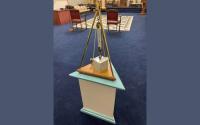What is a lewis?
01 April 24
The stonemason’s lewis is a device used in raising and lowering stone blocks in the course of building construction as exemplified by the smooth ashlar in the tripod usually found on or by the Senior Warden’s chair.
The Romans, in their day, are thought to have used it in the building of the Flavian Amphitheatre and the Saxons in the building of Whitby Abbey in the seventh century.
There is evidence for believing that the device was employed in putting into place some of the more massive stones of Hadrian’s Wall or Roman Wall (AD120– 209) for what appears to have been lewis holes can still be seen in parts built by the Roman Emperor Severus, who heavily repaired the wall in AD209.
The stonemason’s lewis is a grapnel, for which a specially shaped socket needs to be cut in the top face of the blocks of hard, strong stone to be lifted. Two opposite sides or ends of the socket are undercut, not all four as often portrayed. Two wedge- shaped tapered steel pieces are inserted into the socket and between them is inserted a parallel steel spacer, which spreads the wedges into the undercut parts. A shackle pin, or bolt, is passed through the upper extensions of all three and provides a hold for the lifting chain. (The illustration shows how the device works.)
The precise purpose of the lewis is to allow the hoisting chain of the tripod, derrick or crane, to raise the stone and then lower it into its exact final position into the structure, which would not be possible if chains, or ropes passed underneath the stone.
When the stone is in its exact position, the metal key and shackle bolt is removed, thus allowing the spacing piece to be withdrawn and then the two wedges.
Thus, the lewis not only provides the stonemason with a convenient method of attaching the hoisting chains to the stone, but also the ability to lift the heaviest stones with the minimum expenditure of physical effort.
Clearly the lewis may be regarded as an appropriate symbol of STRENGTH – a double symbol, in as much as its name has been given to the son of a mason, his duty being to bear the burden and heat of the day so that his parents may rest in their old age, thus rendered the ‘twilight’ of their lives peaceful and happy.
The double symbolism is mentioned in some old catechisms but the normal Craft ritual does not refer to it, although the device has a place in Mark Masonry.
From a late 18th century catechism, comes the following:
- What do we call the son of a Freemason? A lewis.
- What does that denote? Strength.
- How is a lewis depicted in a Mason’s lodge? As a cramp of metal.
- What is the duty of a lewis to his aged parents? To bear the heavy burden etc.
- His privilege for doing so? To be made a mason before any other person, however dignified by birth, rank or riches, unless he, through complaisance, waives this privilege.
There is good ground for believing that the lewis was originally the first son born to a man after that man had become a Freemason.
Article extracted from Freemason magazine, September 2013, page 15.



